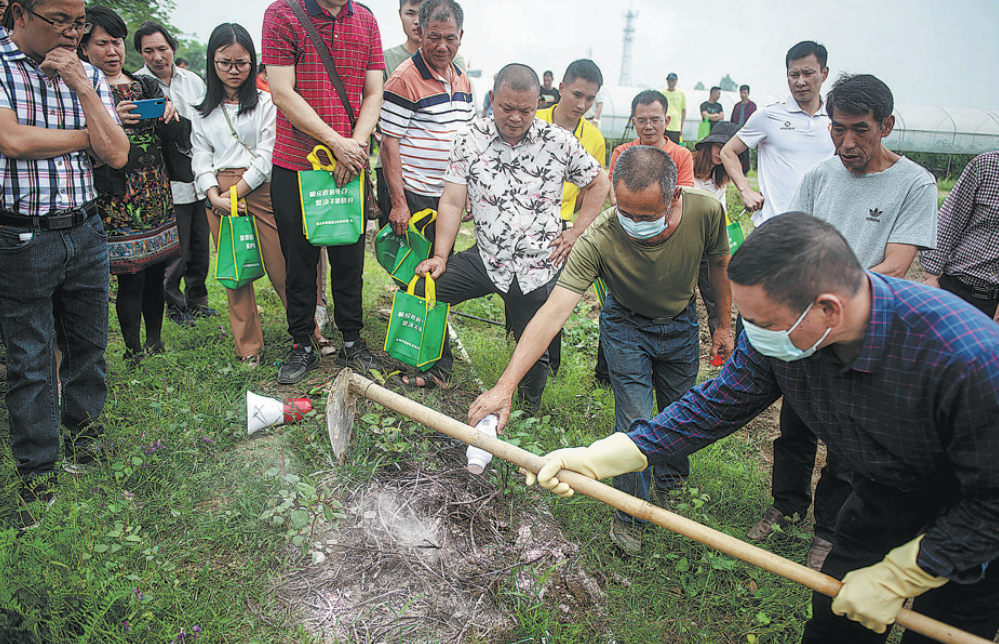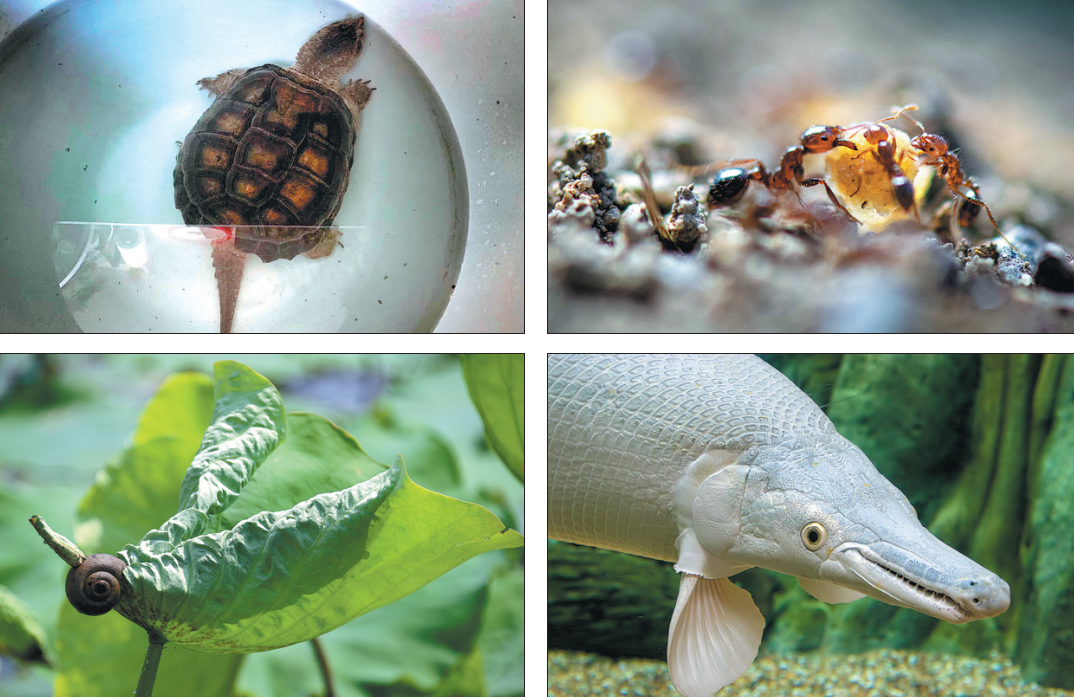
Scientists demonstrate how to contain red fire ants by spreading pesticide in Qingyuan, Guangdong province, in April. XIAO XIONG/NANFANG DAILY
Spread of red fire ants can be slowed, experts say
The advance of invasive red fire ants in China, which can inflict painful bites and stings, can be slowed and made less hazardous through joint prevention efforts by government departments, according to experts.
The species, which is native to South America and arrived in China in 2004, will continue to spread to more areas of the country, however, and may not be eradicated anytime soon, they said.
As of April, the insects had been reported in 12 provinces and 448 counties, according to the Ministry of Agriculture and Rural Affairs. The number of counties in which the ants have been detected has doubled in five years, and they have been sighted in parks and farmland in urban areas.
Lu Yongyue, director of the red fire ants research center at South China Agricultural University in Guangzhou, capital of Guangdong province, said, "The ants' advance will be slowed, for example, from them reaching some 30 counties a year to just a dozen, reducing the risk of them causing serious harm."
When the ants were initially reported in China-in Wuchuan, Guangdong-Lu was among the first group of agronomists to handle samples of the insects.
In September 2004, an agricultural scientist from the Wuchuan agricultural bureau went to Guangzhou and returned with the samples to the research center, where Lu was working.
"The scientist told us an ant infestation had occurred in Wuchuan, and villagers were being bitten and stung. The situation was serious, but they had no idea what to do with the ants, which were thought to be a new species," Lu said.
The provincial agricultural department quickly sent experts to Wuchuan to carry out an investigation. In just one week, after extensive observation work and laboratory studies, the experts concluded the insects were red fire ants that had arrived in China from overseas.
"It was the first time these ants had been reported in China," Lu said.
Experts said the insects could have arrived in the country via imported waste. "According to inspection and quarantine bureau data, a large proportion of the ants intercepted were found on such waste," Lu said.
For the past 17 years, the destructive ants have spread to southern areas of China and also headed north and west, wreaking havoc on farms and in homes.
Production losses
The ants can damage crops by biting into their roots and leaves. "In the worst case scenario, an infestation of red fire ants could result in production of sweet potatoes falling by 30 percent," Lu said, adding that corn, soybeans and vegetables are at risk in areas in which the ants have been reported.
Luo Lizhi, a researcher at the Chinese Academy of Agricultural Sciences' Institute of Plant Protection, said the ants not only jeopardize crops and fruit, which leads to production losses, but also destroy bee hives and harm poultry and pets.
People bitten by the ants experience swellings, nausea and even shock, affecting their ability to work.
A red fire ant grips the skin with its powerful upper jaw before it starts to bite and inject venom. The wound usually leaves scars that last for several weeks or longer. Severe cases can result in chest pain, respiratory failure, anaphylaxis (a severe allergic reaction) and even death.
"Children and farmers have a higher risk of injuries. In some villages, more than 90 percent of the population has been bitten by red fire ants," Luo said. He added that in 2014, farmers in Huizhou, Guangdong, left nearly 100 hectares uncultivated due to an infestation of red fire ants.
One researcher on Lu's team was stung by red fire ants hundreds of times without showing any serious symptoms during his six-year field study, but later experienced semishock and was sent to the hospital after being bitten again.
"People can display no clear symptoms after being attacked by red fire ants, as this case shows. The researcher little expected to experience semi-shock after studying them for years," Lu said.
The ants can also gnaw through the wire of electronic devices, cutting the power and damaging communications equipment.

Some 660 invasive species have been detected in China, including turtles, red fire ants, white alligator eels and Pomacea canaliculata, a type of snail. Du Lianyi / China Daily, Xiao Xiong / Nanfang daily, Provided to China Daily and Xiao Yuanyang / for China Daily
On the march
Luo said the number of counties in which the ants have been detected is 15 times higher than when they were first reported in China in 2004. Their strong reproductive ability, adaptability and low number of natural enemies are among the reasons they have spread so quickly.
"Each queen ant, with an average life span of seven years, can produce 100,000 to 250,000 eggs per year. Each ant nest can have dozens of queen ants, so they reproduce really fast," Luo added.
To ensure they have sufficient food, red fire ants attack and eat anything they like. They have adapted to different conditions in southern areas of China, except for virgin forests. The ants, which can be carried by birds and even humans, spread through grass-covered ground and plants, and on water, Luo said.
In the Pantanal region of South America, the world's largest tropical wetland area, where the ants originate, they are mainly contained by natural enemies, including 23 species of flies.
"When the ants arrived in China, there were no natural enemies to contain them, which allowed them to spread fast," Luo said.
Lu, from South China Agricultural University, said the main reason the ants have spread so rapidly in China is the failure to intercept their transmission routes. "About 80 percent to 90 percent of the fire ants spread through grassy areas, plants and flowers … This poses challenges to control work," he said.
Only having two or three workers from a county inspection and quarantine bureau is barely sufficient to monitor a high number of registered plant growers, he added, so cross-departmental cooperation is needed for effective prevention and control efforts.
Campaign launched
In March, the Ministry of Agriculture and Rural Affairs launched a campaign to combat red fire ants along with eight related authorities, including the Ministry of Housing, Ministry of Transportation, the National Health Commission and the National Forestry and Grassland Administration.
Lu said the campaign would help solve the problem.
"I proposed in a video conference with provincial housing and construction departments earlier this month the addition of one or two standards regarding project inspection work for red fire ants," he said, adding that this will improve the efficiency of control work.
A Ministry of Agriculture official said the campaign is expected to effectively contain the spread of red fire ants in three to five years, ensuring a stable increase in grain production and helping prevent the insects from biting and stinging people.
To date, 40 effective pesticides have been registered and new equipment such as drones and bait spreaders has been used for control work, the department said.
Some of the bait and technology used to catch the ants in parts of Guangdong and Fujian provinces and Guangxi Zhuang autonomous region has been successful in eradicating the pests.
"So far, bait is regarded as the best way to control these insects," Luo said.
China is expected to strengthen efforts to improve education and management related to the technology used to contain the ants, experts said.
During an inspection visit, Lu witnessed some county-level governments using the wrong way to get rid of the ants.
"They didn't know they were misusing the technology, or insisted on trying a less effective method," he said, adding that some authorities showed an incorrect photograph of a red fire ant when reporting on efforts to contain the insects.
Moreover, the public, especially farmers, who are more likely to encounter the ants, should be taught by professionals about the danger the insects pose and how they should protect themselves, Lu said.
He added that a popular science website in China once incorrectly claimed that only 3 percent of people were allergic to red fire ants. "Basically, 95 percent to 99 percent of people are allergic to the ants to some degree, although I believe 3 percent have a serious reaction if they are bitten or stung," he said.

Luo Lizhi, a researcher at the Chinese Academy of Agricultural Sciences' Institute of Plant Protection, studies red fire ants in Louisiana, United States, with a scientist from the US. Photo provided to CHINA DAILY
Successful work
The Biosecurity Law, which took effect on April 15, is expected to promote the prevention and control of invasive species, including the red fire ant.
China has successfully eradicated the pests in six quarantine areas, including Zhangjiajie National Forest Park in Hunan province, but Lu feels that the battle between humans and the insects will not result in victory for either side.
"Although these ants may not be eradicated nationwide, they could adapt to our ecosystem and live alongside some domestic species in the future," he said.
Luo, the CAAS researcher, said studies have shown that tumblebugs, or dung beetles, were found in the nests of red fire ants. Their studies also found that the fire ants bite each other.
To date, the control area for red fire ants covers 267,000 hectares, accounting for more than 80 percent of the areas nationwide in which the insects have been reported, according to the Ministry of Agriculture.
Last month, six inspection teams comprising officials from nine government departments were sent to a total of 12 provinces and cities to guide prevention and control work, carry out investigations, contain infestation sources, and eradicate the ants in key areas.
In Guangdong, the provincial department of agricultural and rural affairs aims to largely contain serious infestations of red fire ants by the end of 2023. The construction department will step up park patrols, while the department of natural resources will keep a close watch on forests and wetlands.
In addition, one or two insecticides stores will be set up in each village in the province, with a range of insecticides assessed for effectiveness and scientific use.
In spring, more than 40,000 people attended 180 courses throughout Guangdong to learn about red fire ants from professionals.
Li Wenfang contributed to this story.
原文链接:https://enapp.chinadaily.com.cn/a/202106/16/AP60c93b34a310f03332fa1cef.html